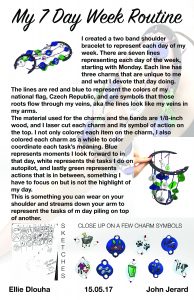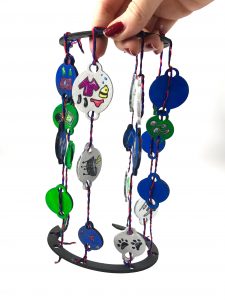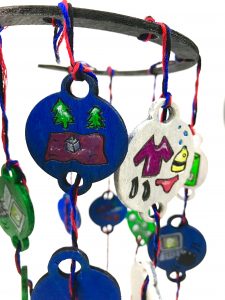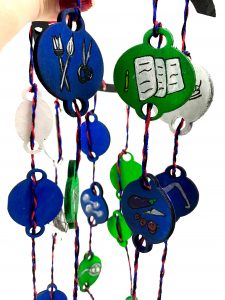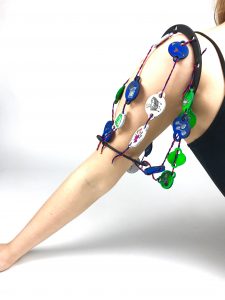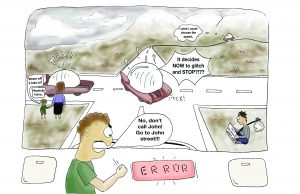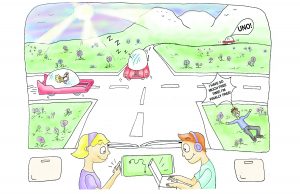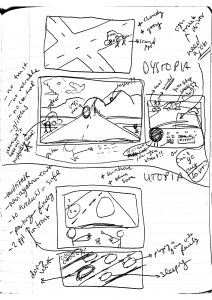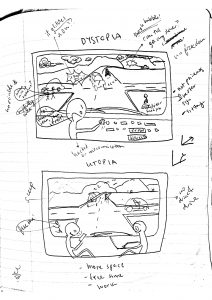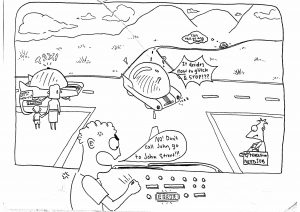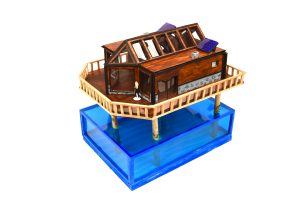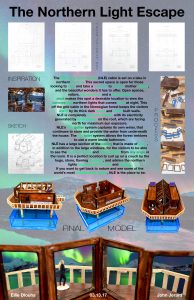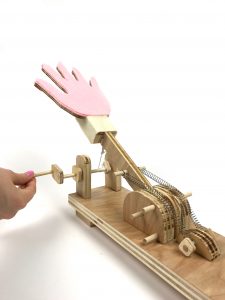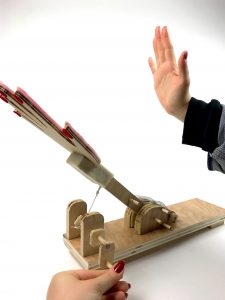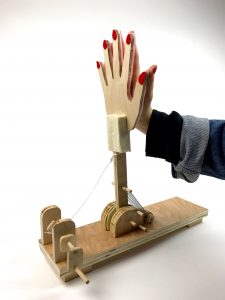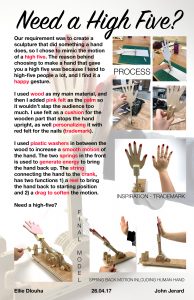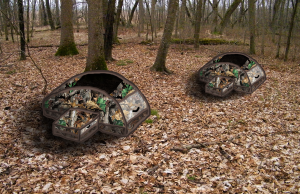A two part shoulder bracelet that contains charms that represent my week into sections and tasks.
Monthly Archives: May 2017
studio 2 – BRIDGE 5: FINAL PROJECT OUTCOMES
Do these two extreme images of self-driving cars evoke questions about the future?
These two drawings are representations of each end of the spectrum, of a possible and extreme future of self-driving cars. One is a dystopia of all negatives outcomes, possibilities and fears of a life filled with SDC. And another is a utopia of all the benefits SDC could have to offer for our world and people. My goal, by creating such extremes, was to get the audience to ponder about what they imagine the future to look like, and to spark curiosity about the future of AI.
Each scenario was compiled from the research I did by asking humans of New York about what their thoughts, benefits and fears were about self-driving cars.
Technology is exponentially growing and the concept of Artificial Intelligence is already being incorporated in many products today. Self-driving cars is evidence of companies trying to invent the new breakthrough in technology, and when successfully create, self-driving cars will change the world drastically. It’s easy to automatically think positively or negatively about SDC, so these two comparisons can show both perspectives and evoke new thoughts.
I want to include in this post each scenario in each drawing just in case not everything was caught. Dystopia: 1) Furthest car in the distance the passenger is complaining about the loss of freedom to choose the speed of the car. It was from answers I got from loss of freedom about speed and the choice of where you can go. 2) Taxi car on the left has two people scared to go inside because they are not sure if it will be safe. Adapted from interview feedback about reliability of self driving cars, and if the car will get hacked. 3) Car in the middle of the intersection is from answers about what if the self driving cars glitch in dangerous situations. 4) The man sitting on the grass, is the possibility of all car related jobs going out of business leaving millions of people unemployed. Taxi car on the left, taxi driver now out of business = man on the grass. 5) Angry man in the middle of the image, in the car, is the situation when the car does not exactly get your voice recognition or finger touch.
Utopia: 1) Furthest car in the distance is the possibility that people can then play games with their sibling, friends etc. so I chose the card game UNO, and having a person yelling UNO! 2) Car in the middle of the street with Z’s is from feedback that people would want to sleep more in their commute to work/school etc. 3) Car on the left is of a woman drinking so their would be no casualties of drinking and driving as well as people who want to drink but still go places. 4) the free man on the grass was from results of people saying SDC would open up more free time for them. 5) The kids in the car in the front of the drawing, was from answers from interviews about multitasking and needing more time to do work, or need time to call relatives, or need time to unplug in between school and work. So I adapted those answers to a girl on her phone texting her friends away/face timing, and a boy doing work/playing games.
Dystopia has dull colors(and red = danger) and a gloomy day = represents a bad future. Utopia has flowers blossoming, sunshine, bright colors, birds and the color green for successful.
These are my first sketches of when my idea took on from 1 final image to two images. I was not sure at the beginning if I wanted the utopia and dystopia to be from the same angle on the streets, so the second half of the paper is the possible utopia future from birds eye view, where the top half was the dystopia view from the inside of a car.
This was when I developed my ideas on perspective and view point of the two images to be from the same angle. Dystopia upper sketch, and utopia lower sketch. Both have notes showing my thinking process of where I wanted which situation (that I conducted through my interviews and research) in the streets.
This was my one dystopia image I brought into class for feedback. I did not have my colors in yet which was a comment I got that said it would definitely help show the contrast between utopia and dystopia better, which I agreed with. Also my peer’s comment was that the text was too small, so I was sure to make it readable in the final outcome. Another note was that the character that looked too much like cartoon Phinneas would distract from the actual concept/moral of the image so I was sure to make all characters not associated with tv shows so the focus was mainly on the point behind the scenes. Also, it wasn’t clear to everyone that the ‘Phinneas’ was sitting and that his board was in fact a cardboard sign, so I made it more visible in the final. Lastly, another change I made was that the inside of the car needed more elements of a car, so I changed it to have glove compartments and changed buttons to a touch screen to give more of a ‘futuristic’ feel.
Throughout the entire process of my final project I changed and adapted a lot of my ideas. The main change that I noticed was how the final image/s turned out. From the beginning I imagined my final to be one drawing done on photoshop of a future of self driving cars (SDC), and my point and RQ was to give the answer of what it could be like. I imagined before interviewing people of New York about the topic, they would generally think SDC would be positive, but throughout my interviews with people and investigation, I realized a lot of people had such different takes and a lot of negative outlooks on the possibility. This changed my perspective on what my final should look like. Since I got a lot of feedback, I wanted to categorize it into two drawings of all positive ideas of SDC and negative scenarios of SDC. Then I thought about the scene which all these scenarios take place, and that is when I decided if I were to make a ‘all good’ outcome and ‘all bad outcome’ why not make them extreme futures? So that is how I incorporated the utopia and dystopia ideas. With this idea of creating two versions of extremes, I instead of giving the answer, I wanted the audience to question the piece. Or more like allow the paintings to evoke questions within themselves about what they imagine the future to be like. This was where I decided I wanted my final to be intellectually interactive, and needed time to think and analyze the piece, rather than bluntly giving away the answer.
Throughout this process, I was also experimenting with drawing on photoshop, but soon realized I liked the freehand drawing/style I did with a pen and paper. So I decided I would do the whole thing on paper. After I finished the black and white version, I realized it will be more effective and powerful to scan it, and photoshop the colors in and get a vibrant, powerful and variety of colors. So in the end I used both, instead of just one material. And as I mentioned earlier, with my sketches, is how I took in and developed my piece after the helpful critique I got from my peers.
Studio 2 bridge 5 final reflection
based on your current experience and ideas how might you answer the question what is research?
Research is the complete process of starting with an idea/ideas, until the completion of your project. After my experiences in many projects over the course, I have come to realize that research is not simply getting facts form the internet or interviews, but it continues when you try something and it does not work so you have to find out new ways. Research involves change and adaptation, the project can change dramatically by the end and the user needs to be open to adapting to change. New materials can found or new information could change the idea. Research can be the information from books or online sources, but it can also be the research you do find yourself through crafting a project through your eyes.
over the course of the semester what did you find or develop in your own practice as a maker/thinker?
Over the integration course of both seminar and studio I found that, in particular to this semester, I have a good sense of conceptual thinking. In my seminar research paper most of the problems the teacher was seeing in the class’s work was that they had facts and sources but not a big idea – the conceptual idea. To me specifically she told me that was not the case, I had the idea just need to cite it more (I had my sources I just needed to quote them more). It was interesting to realize I think in terms of the idea first and not the facts, maybe it was particular to that essay, but now I will notice it more often in my future papers, which side I start from.
how did your concept of both research and your own practice change or developed over the course of the semester?
in studio it went from one image and gave an answer – to two images that create questions
My research topic idea in seminar changes dramatically, it started off as an idea about how self driving cars will affect us and the artificial intelligence link to self driving cars are, to choice anxiety. Over the weeks brainstorming the first topic and trying to poke the idea in every angle, it wasn’t until Brie looked at my paper and from an outsiders perspective highlights what was most interesting and what could actually be more interesting than the common topic of SDC fears and worries. AI is a tool used in many products that help make our lives easier, by creating more time. In the added abundance of time we get an overwhelming amount of choice of what we can do in that time. That is where I talk about the hidden side affect from AI products, the situation you get yourself into when you have so much to choose from, you end up not being satisfied with anything you choose because its easy to think that another choice could have been perfect. Even if the result was great, it dampers the decision making process.
In studio my concept of the final project changed dramatically as well. My whole perspective changed from wanting to present one image of the future of self driving cars, and providing an answer to how it could be. To ending up with two images that instead evoke questions in the audience’s heads. After editing my initial idea, I realized I didn’t want to tell people what to think or that there is a definite answer. I wanted the audience to have to look at my piece and create their own scenarios from the two extreme futures of a dystopia and a utopia world of a life with self driving cars.
how do you see this in your work overall this semester, and where do you imagine it might go next?
Artificial Intelligence ties with a lot of my projects over my first year at parsons, and everything to do with design and technology being immersed together. I definitely want to continue pursuing these ideas, which I plan on doing in my major: design and technology. Next year my courses will be more major focused, and my field is about combining those fields, so I plan on diving into it next year. Since I am so passionate about this, I think I only scratched the surface of what I can possibly do with this field.
Seminar 2 – systems and strategies: 2 year reflection
I’m Ellie, a Czech girl who moved to New York to start her next big adventure. I’ve never moved and come from a small city filled with the outdoors and nature, so the move to New York City was a big change. I am interested in combining the design artsy side with the computer science/technological side by studying design and technology at Parsons. Parsons is one of the only school that allowed me to combine these two topics because in Europe they want you to either, become an artist or a computer scientist.
By looking over all the work I have accomplished in my first year at Parsons I have noticed many differences and similarities in my pieces. A common theme I have included in my work is nature and AI technology. From my project in studio 1 making alien creatures that were based on the outdoors to choosing my space and materiality house project being in the middle of a forest in northern Norway. I used the topic AI in several projects, in semester 1 I used it in both studio and seminar projects, either literally or the concept taking on public surveillance systems etc., in my drawing and imaging class for an eerie poster, and in my Time class in a video about AI among us. And in seminar 2 I’ve used it in my research paper about how AI turns into choice anxiety. Including the seminar and studio courses over the entire year within topic, it really helped deepen my research and understanding in the topics I was creating projects for. It deepened my knowledge for the topic because it would not be just one type of research, either online or sketching, it was both. It was the process of investigating each individual aspect like facts as well as creating it into a visual, allowing you as the maker to really get a grasp of what the big picture is.
One of my main highlights of my first year at parsons was creating a 3D model of my invented house, in my space and materiality class. This project started out as an idea, that then turned into intense technical drawings of the floor plans and elevation views, that then turned into making a a smaller version model of the imaged house. The only criteria were to create a communal area, thats sustainable, where you go to unplug. My idea was to create a observatory cabin in the forest in northern Norway on a Lake, over looking the northern lights and stars in the night. The sustainable aspects were drains for water collection and storage, dry toilet, and solar panels so that the cabin could be completely self sustainable. This was an important project for me because it was a rigorous, time consuming, lots of adapting process that allowed me to learn a lot about my abilities and about my self and how I think. It pushed me to achieve greater than I believe I could which is what I hope to do in every class because that is the ultimate lesson. The final outcome turned out really well, and I am proud of my achievement and dedication to the project. I have never worked with many of the materials that went into this project so it was a lot of figuring out and self learning. It was an area of work I have never explored so it was as successful as it was interesting to me.
My second highlight would be my teacher John Jerard for my space and materiality class. His class in general over the course of the second semester was truly educational, inspiring and motivational. John is a very exceptional teacher that brings in insightful knowledge from the outside real world through his many years of experiencing it, and his the other schools he teaches as well as the hospitals he comes to to help out making art. He makes use of the class time most effectively and everyday (i had the class twice a week) would push me to do better, to do greater. He supported me while at the same time told me the harsh truth about what needs to be done, or what is needed from me in my presentation boards, photography, presentation, and dedication. Teachers area very important to my learning, and I am very thankful he was one of those teachers that truly made an impact on me.
The skill of being able to create and understand technical drawings as well as knowing my capabilities of creating objects from my hands will definitely impact my future projects in the next years at parsons and life. It allows me to have a better understanding and thinking of how I can take on my next assignments in ways I never thought I can display them. John class also really pushed me to use all the great resources the school has to offer, which a lot of classes never talk about or encourage. Like the professional photography room on floor 10 (photos above taken there). These elements do generate better quality and presentation for the future. I have dabbed a bit in the wood working shop and the laser cutting area this semester but I would like to expand my skills in those areas to get more familiar and comfortable to generate wicked projects in the future. I also want to get a deeper skill in coding which I hope to learn in my coding class in the fall. From my drawing and imaging class from my first semester, we had a woman come and present to us her work and told us about how important the presentation is for the visual of your object in the real world. That is when I learned the first steps in incorporating my projects to blend in the real world to give the audience a glimpse of my thought of how the product will be used. I would like to improve my photoshop skills so that the presentation editing looks flawless.

